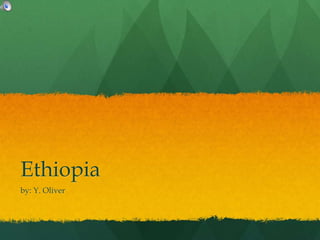Ethiopia
- 2. Native People ï The native people of Ethiopia include the Oromo, Amhara, Somali, Tigray, Sidama, Gurage, Welayta, Hadiya, Afar, Gamo, and Gedeo. ï Currently, nearly 100% of the population is native. ï Some of the ancient ruins include the Ruins of Aksum.
- 3. The Ruins of Aksum ï They are the ruins of the ancient city of Aksum, located near Ethiopiaâs northern border. ï The ruins date from the 1st to 12th century CE. ï The ruins include monolithic obelisks, giant stelae, royal tombs, and ancient castles. ï It declined politically in the 10th century CE, but Ethiopian emperors continued to be crowned there.
- 4. Colonization ï Ethiopia is considered to never have been colonized. Since it has never been a colony, it didnât gain independence from anyone. ï Ethiopia became an independent nation in 1137, and the current constitution was established in 1991.
- 5. Government ï Ethiopia is a Federal parliamentary republic. In fact, the full name of the nation of Ethiopia is the Federal Democratic Republic of Ethiopia. ï Everyone in Ethiopia is friendly (well, at least, mostly everyone), so it is therefore safe.
- 6. Economy ï Ethiopiaâs GDP per capita is $1,092. That is one of the lowest in the world. ï The GDP total is $94.878 billion. ï The currency in Ethiopia is Birr. 17 Birr is the equivalent of 1 U.S. Dollar. ï Agriculture is accountable 41% of economy and accounts for 85% of employment in Ethiopia. ï The major export crop in coffee. ï 13% of economy is from industry, 46% is from the service industry. ï The poverty rate is 29.2%. ï Some of the industries of Ethiopia include food processing, beverages, textiles, leather, chemicals, metals processing, and cement. ï No oil production, yet they use approx. 47,000 barrels a day.
- 7. Economy (continued) ï Ethiopia and Eritrea were at war for a long time and Eritrea took all of Ethiopiaâs remaining coastline. Now Ethiopiaâs only port is in Djibouti, and the road to Djibouti is two lanes. Nearly all of Ethiopiaâs imports and exports are transported on the little road in tons of diesel trucks. And this is the good part!
- 8. Climate/Topography ï The landscape of Ethiopia includes mountains, dissected plateaus, the Great Rift Valley, lowlands, steeps, and semi-desert. Basically, the landscape is very diverse. ï The best time to visit Ethiopia climate wise is the dry season, which is September to February or May.
- 9. Tourism ï Sports of Ethiopia include soccer and athletics. Ethiopia is also famous for its world-class runners. ï Places to go include Simien Mountains National Park, Lalibela, and the Tombs of Kings Kaleb and Gebre Meskel. ï Also, Ethiopian food is amazing!!!
- 10. Simien Mountains National Park ï This national park has excellent trekking, amazing views, and a large variety of wildlife. ï The wildlife of this park includes walia ibexs, gelada baboons, Ethiopian wolves, rock hyraxes, jackals, bushbucks, klipspringers, thick- billed raven, black-headed siskin, white-collared pigeons, white-billed starlings, wattled ibis, spot- breasted plover, white-backed black tit, and Ankober seedeater/serin.
- 11. Lalibela ï Lalibela is a collection of 11 churches. Not just any churches, churches carved out of the ground! Yes, you heard me right, out of the ground!!! Of course they are therefor at the bottom of a pit, with their roofs at ground level. They are actual buildings that you can go inside, not something like earthen platform mounds. From a birds eye view, the look like giant red stone crosses. They have been kept by generations of priests who protect their treasures (such as illuminated Bibles, illustrated manuscripts, and ornamented crosses. ï Lalibela is located about halfway between Addis Ababa (the capital) and the northern part of the boarder. ï The altitude of Lalibela is 2,630 meters, or 8629 feet, above sea level. ï The admission is 100 Birr, the equivalent of nearly 6 U.S. Dollars.
- 12. Food/Drink ï Some Ethiopian food includes Doro wat, shiro wat, beef fillet tibs (one of my personal favorites), lamb tibs, kitfo, eggs, avocado juice (which my mom likes), Tej, fresh fruit juices, Ethiopian beer, many vegetables (especially onion, tomato, garlic, and peppers), NO pork or shellfish, and tihlo. ï All of the food is served upon injera, a flat, sourdough, pancake-like bread made from tef (a grain indigenous to Ethiopia) as well as other ingredients. Injera is also used as an edible utensil by scooping up and eating the food along with the injera
- 13. Other Facts ï The national language of Ethiopia is Amharic, but many people there also speak English. ï There are 82 other languages spoken in Ethiopia. ï The characters in Amharic go by syllable. ï Ethiopia is set at a very high altitude, so altitude sickness in tourists is somewhat common. ï The time is 11 hours ahead of Kodiak, so some major jet lag may occur.
- 14. The Ethiopian Location of flag. Ethiopia on globe The Simien Mountains. Me eating beef fillet tibs
- 15. One of the Lalibela A dish of injera with churches. various foods. Some Ethiopians travel by horse-drawn carriage.
- 16. There is sometimes cattle being herded in An example of some the middle of the city. Ethiopian housing. Another example of some housing.
- 17. My brother and I. Iâm learning about Ethiopia for it is my brotherâs homeland.
- 18. References ï Wikipedia.com ï Wiki Answers ï Yahoo Answers ï Lonely Planet ï CIA ï Google Maps ï visualgeography.com ï My mom ï My nana

















